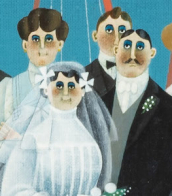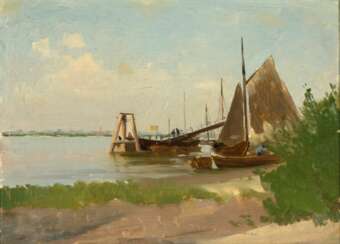becking

Horst Becking is a modern German artist, a leading exponent of Abstract Expressionism.


Horst Becking is a modern German artist, a leading exponent of Abstract Expressionism.


Carl Spitzweg was a German romanticist painter, especially of genre subjects. He is considered to be one of the most important artists of the Biedermeier era.



Friedrich Becker was a German artist, jeweler, and inventor of kinetic jewelry.
Friedrich Becker is one of the most influential jewelers of the second half of the twentieth century. He became known primarily for his avant-garde projects of kinetic jewelry and large kinetic objects.
Becker was interested in kinetics, the interaction of force and motion already during his apprenticeship years. He first trained as a mechanical engineer, then joined the aviation department. Only after World War II did he "make the reckless decision to become a jeweler." After training as a jeweler, he studied at the Werkkunstschule and then founded his own workshop in Düsseldorf, becoming a professor at the Düsseldorf University of Applied Sciences.
Becker experimented and supplemented various jewelry pieces with interchangeable stones and eventually developed kinetic jewelry. He was not only the inventor of kinetic jewelry, but also revolutionized the jewelry market with the introduction of stainless steel and synthetic gemstones. Each kinetic piece by Friedrich Becker is a perfect symbiosis of form, color and material.


Paula Moderzohn-Becker was a German early expressionist painter.
In her youth she attended the traditional School for Women Artists in Berlin. Like many local German artists, she painted sentimental landscapes and scenes from peasant life.
And in 1900 Paula traveled with her husband to Paris, where she was influenced by post-Impressionist paintings and became an ardent enthusiast of painting by Paul Gauguin and Paul Cézanne. Today she is considered a forerunner of Expressionism because of the power of her compositions, although during her lifetime she was completely ignored. During her short career Moderzohn-Becker painted 750 canvases, about 1,000 drawings and 13 etchings, all of which incorporated the major art movements of the early 20th century.






Carl Emil Rudolf Ludwig Becker was a German marine artist.
He was awarded gold medals at the International Art Exhibition of 1894, in Vienna, and the Große Berliner Kunstausstellung of 1896. Three years later, he was one of the co-founders of the Düsseldorfer Künstler-Vereinigung (artists' association). After the turn of the century, marine painting was heavily promoted by Kaiser Wilhelm II, who was attempting to make Germany a major sea power. As a result, the demand for Becker's paintings increased farther inland.


Boris Becker is a German photographer, filmmaker and former publisher. The motifs of his works are mostly constructions and details from architectures and landscapes.


Boris Becker is a German photographer, filmmaker and former publisher. The motifs of his works are mostly constructions and details from architectures and landscapes.


Boris Becker is a German photographer, filmmaker and former publisher. The motifs of his works are mostly constructions and details from architectures and landscapes.


Boris Becker is a German photographer, filmmaker and former publisher. The motifs of his works are mostly constructions and details from architectures and landscapes.


Carl Emil Rudolf Ludwig Becker was a German marine artist.
He was awarded gold medals at the International Art Exhibition of 1894, in Vienna, and the Große Berliner Kunstausstellung of 1896. Three years later, he was one of the co-founders of the Düsseldorfer Künstler-Vereinigung (artists' association). After the turn of the century, marine painting was heavily promoted by Kaiser Wilhelm II, who was attempting to make Germany a major sea power. As a result, the demand for Becker's paintings increased farther inland.


Friedrich Becker was a German artist, jeweler, and inventor of kinetic jewelry.
Friedrich Becker is one of the most influential jewelers of the second half of the twentieth century. He became known primarily for his avant-garde projects of kinetic jewelry and large kinetic objects.
Becker was interested in kinetics, the interaction of force and motion already during his apprenticeship years. He first trained as a mechanical engineer, then joined the aviation department. Only after World War II did he "make the reckless decision to become a jeweler." After training as a jeweler, he studied at the Werkkunstschule and then founded his own workshop in Düsseldorf, becoming a professor at the Düsseldorf University of Applied Sciences.
Becker experimented and supplemented various jewelry pieces with interchangeable stones and eventually developed kinetic jewelry. He was not only the inventor of kinetic jewelry, but also revolutionized the jewelry market with the introduction of stainless steel and synthetic gemstones. Each kinetic piece by Friedrich Becker is a perfect symbiosis of form, color and material.






Gerlinde Beck was a modern German abstractionist painter, graphic artist and sculptor.


Paula Moderzohn-Becker was a German early expressionist painter.
In her youth she attended the traditional School for Women Artists in Berlin. Like many local German artists, she painted sentimental landscapes and scenes from peasant life.
And in 1900 Paula traveled with her husband to Paris, where she was influenced by post-Impressionist paintings and became an ardent enthusiast of painting by Paul Gauguin and Paul Cézanne. Today she is considered a forerunner of Expressionism because of the power of her compositions, although during her lifetime she was completely ignored. During her short career Moderzohn-Becker painted 750 canvases, about 1,000 drawings and 13 etchings, all of which incorporated the major art movements of the early 20th century.


Paula Moderzohn-Becker was a German early expressionist painter.
In her youth she attended the traditional School for Women Artists in Berlin. Like many local German artists, she painted sentimental landscapes and scenes from peasant life.
And in 1900 Paula traveled with her husband to Paris, where she was influenced by post-Impressionist paintings and became an ardent enthusiast of painting by Paul Gauguin and Paul Cézanne. Today she is considered a forerunner of Expressionism because of the power of her compositions, although during her lifetime she was completely ignored. During her short career Moderzohn-Becker painted 750 canvases, about 1,000 drawings and 13 etchings, all of which incorporated the major art movements of the early 20th century.


Wolfram Beck was a German sculptor, draughtsman, and painter who worked with wood, steel, bronze, acrylic, and stone. He was trained at the Higher School of Artistic Culture in Berlin, and his work initially included large organic wooden works, portrait busts, and torsos in clay and stone. In the 1970s, Beck created strictly geometric and airy-filigree constructions from mechanical and electronic components that could be moved by actuators or by hand. He also created colorfully accented and fragile looking objects in metal and acrylic. Beck's work can be found in the collections of Axel Springer, Egon Eiermann, and others.


Paul Herbert Beck was a German expressionist watercolor painter.






























































